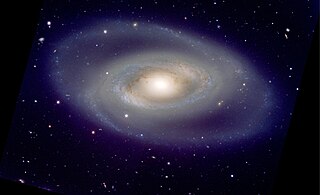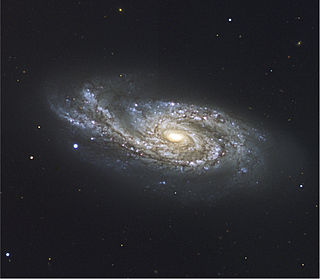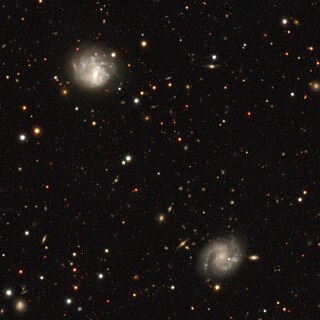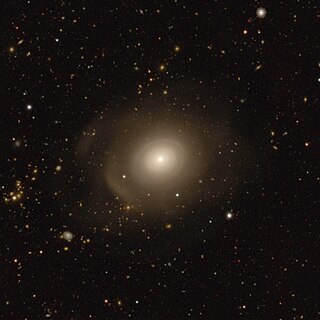
NGC 4088 is an intermediate spiral galaxy in the constellation Ursa Major. The galaxy forms a physical pair with NGC 4085, which is located 11′ away.

NGC 1350 is a spiral galaxy located 87 million light years away in the southern constellation Fornax. It was discovered by Scottish astronomer James Dunlop on 24 November 1826.

NGC 3504 is a barred spiral galaxy in the constellation Leo Minor. It has a Hubble distance corresponding to 88 million light-years and was discovered by William Herschel in 1785.

NGC 4790 is a barred spiral galaxy located in the constellation of Virgo. Its velocity with respect to the cosmic microwave background is 1679 ± 24 km/s, which corresponds to a Hubble distance of 80.8 ± 5.8 Mly (24.76 ± 1.77 Mpc). In addition, six non-redshift measurements give a distance of 74.75 ± 4.07 Mly (22.917 ± 1.249 Mpc). It was discovered on 25 March 1786 by German-British astronomer William Herschel.

NGC 908 is an unbarred spiral galaxy in the constellation Cetus. It was discovered on 20 September 1786 by William Herschel. This galaxy is 56 million light years away from Earth. It is the main galaxy in the NGC 908 group, which also includes NGC 899, NGC 907, and IC 223.

NGC 7072 is an intermediate spiral galaxy located about 210 million light-years away in the constellation of Grus. NGC 7072 was discovered by astronomer John Herschel on September 5, 1834.

NGC 1332 is an almost edge-on elliptical galaxy located in constellation of Eridanus. Situated about 70 million light years away, it is a member of the Eridanus cluster of galaxies, a cluster of about 200 galaxies. It is also the brightest member of the NGC 1332 Group. It was discovered by William Herschel on 9 December 1784.

NGC 788 is a lenticular galaxy located in the constellation Cetus. Its velocity with respect to the cosmic microwave background is 3938 ± 30 km/s, which corresponds to a Hubble distance of 189.4 ± 13.4 Mly (58.08 ± 4.10 Mpc). It was discovered in a sky survey by Wilhelm Herschel on September 10, 1785.

NGC 673 is an intermediate spiral galaxy in the constellation of Aries. Its velocity with respect to the cosmic microwave background is 4894 ± 20 km/s, which corresponds to a Hubble distance of 235.4 ± 16.5 Mly (72.18 ± 5.06 Mpc). In addition, 31 non redshift measurements give a distance of 206.09 ± 5.54 Mly (63.187 ± 1.699 Mpc). The galaxy was discovered by German-British astronomer William Herschel on 4 September 1786.

NGC 3430 is a barred spiral galaxy in the constellation of Leo Minor. Its velocity with respect to the cosmic microwave background is 1,869 ± 20 km/s, which corresponds to a Hubble distance of 89.9 ± 6.4 Mly (27.57 ± 1.95 Mpc). In addition, 22 non-redshift measurements give a distance of 85.97 ± 3.77 Mly (26.359 ± 1.157 Mpc). It was discovered by German-British astronomer William Herschel on 7 December 1785.

NGC 5419 is a large elliptical galaxy in the constellation of Centaurus. Its velocity with respect to the cosmic microwave background is 4,375 ± 23 km/s, which corresponds to a Hubble distance of 64.5 ± 4.5 Mpc. It was discovered by British astronomer John Herschel on 1 May 1834.

NGC 1642 is a spiral galaxy in the constellation of Taurus. Its velocity with respect to the cosmic microwave background is 4575 ± 3 km/s, which corresponds to a Hubble distance of 220.1 ± 15.4 Mly (67.48 ± 4.72 Mpc). However, one non-redshift measurement gives a much closer distance of 69 Mly (21.3 Mpc). It was discovered by German astronomer Heinrich d'Arrest on 29 December 1861.

NGC 7769 is a spiral galaxy in the constellation of Pegasus. Its velocity with respect to the cosmic microwave background is 3855 ± 25 km/s, which corresponds to a Hubble distance of 56.85 ± 4 Mpc. It was discovered by German-British astronomer William Herschel on 18 September 1784.

NGC 1086 is a spiral galaxy in the constellation of Perseus. Its velocity with respect to the cosmic microwave background is 3848 ± 14 km/s, which corresponds to a Hubble distance of 56.76 ± 3.98 Mpc. It was discovered by American astronomer Lewis Swift on 20 August 1885.

NGC 5898 is an elliptical galaxy in the constellation of Libra. Its velocity with respect to the cosmic microwave background is 2301 ± 13 km/s, which corresponds to a Hubble distance of 33.93 ± 2.38 Mpc. It was discovered by German-British astronomer William Herschel on 21 May 1784.

NGC 4330 is a spiral galaxy in the constellation of Virgo. Its velocity with respect to the cosmic microwave background is 1898 ± 24 km/s, which corresponds to a Hubble distance of 27.99 ± 1.99 Mpc. However, a dozen non-redshift measurements give a much closer distance of 19.642 ± 1.559 Mpc. The galaxy was discovered by Irish engineer Bindon Stoney on 14 April 1852.

NGC 7110 is a barred spiral galaxy in the constellation of Piscis Austrinus. Its velocity with respect to the cosmic microwave background is 5044 ± 20 km/s, which corresponds to a Hubble distance of 74.39 ± 5.22 Mpc. It was discovered by British astronomer John Herschel on 23 September 1834.

NGC 3052 is an intermediate spiral galaxy in the constellation of Hydra. Its velocity with respect to the cosmic microwave background is 4122 ± 24 km/s, which corresponds to a Hubble distance of 60.79 ± 4.27 Mpc. However, 19 non redshift measurements give a much closer distance of 42.563 ± 6.434 Mpc. The galaxy was discovered by German-British astronomer William Herschel on 7 February 1785.

NGC 1233 is a spiral galaxy in the constellation of Perseus. Its velocity with respect to the cosmic microwave background is 4218 ± 14 km/s, which corresponds to a Hubble distance of 202.9 ± 14.2 Mly (62.22 ± 4.36 Mpc). In addition, three non redshift measurements give a distance of 211.35 ± 2.14 Mly (64.800 ± 0.656 Mpc). The galaxy was discovered by French astronomer Édouard Stephan on 10 December 1871. It is also thought to have been observed by Lewis Swift on 21 October 1886, and later listed as NGC 1235.

NGC 1493 is a barred spiral galaxy in the constellation of Horologium. Its velocity with respect to the cosmic microwave background is 1004 ± 4 km/s, which corresponds to a Hubble distance of 48.3 ± 3.4 Mly (14.81 ± 1.04 Mpc). In addition, six non redshift measurements give a distance of 35.38 ± 1.71 Mly (10.848 ± 0.525 Mpc). The galaxy was discovered by Scottish astronomer James Dunlop on 2 September 1826.




















